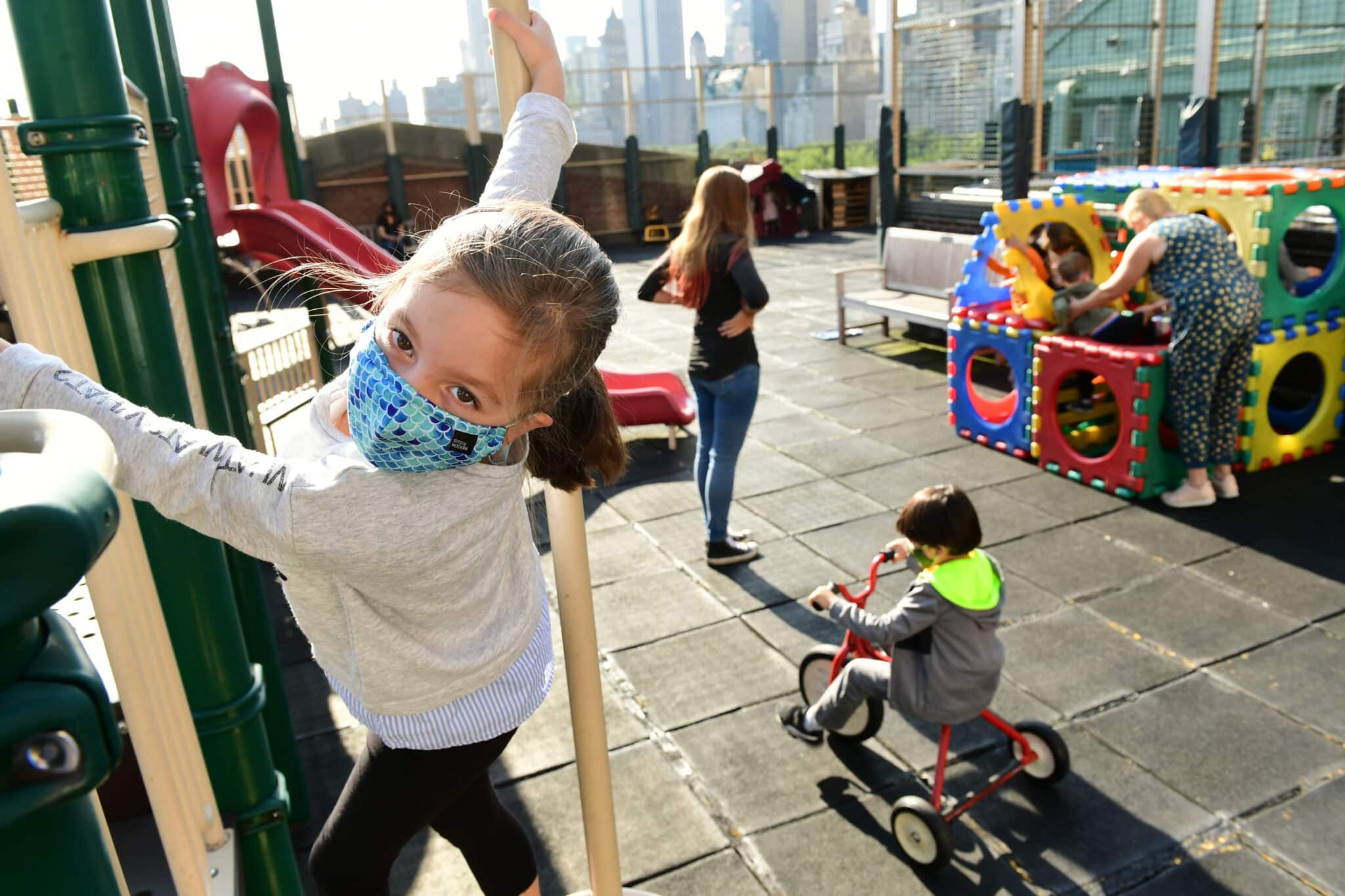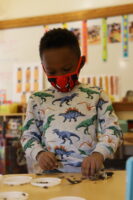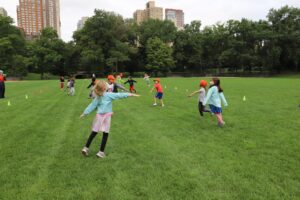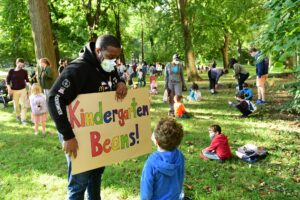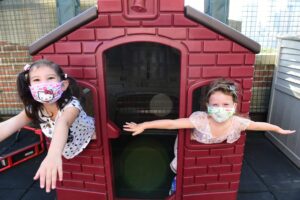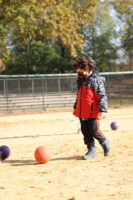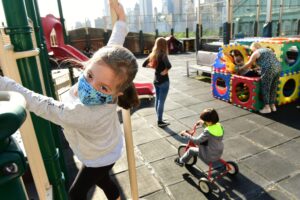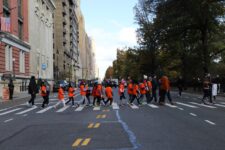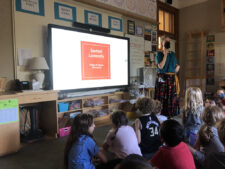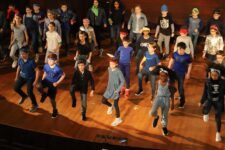On many days, the biggest decision an Ethical Culture Kindergartener must face is whether to start with the wooden blocks or the coloring kit.
As one of the School’s ten tenets of progressive education, playfulness has always been a subject of serious consideration. Faculty and administrators regularly lead curricular planning sessions that center on incorporating fun and games into students’ daily experiences. Even the nomenclature is indicative: In Kindergarten, “work time” is playtime, a dedicated period of the day when students can piece together jigsaw puzzles, doodle illustrations, or build miniature cities.
Play has always been one of the hallmarks of an ECFS education — and in the COVID-19 era, it remains as vital as ever.
The pandemic has complicated how play is implemented while simultaneously underscoring its significance. “Working at Ethical Culture, it always felt like second nature,” says Komal Pasha, Kindergarten Teacher. “Now it’s something that we have to make an effort to be part of our day and consciously prioritize while thinking about the safety and health of every child.”
As student schedules have morphed to accommodate spread-out groups and longer transition times, it would be easy to forgo play, but the Kindergarten team has worked hard to preserve its place in the school day. Part of that effort has involved demonstrating how play can be safely done: At the start of the academic year, Kindergarten teachers devoted plenty of time to modeling how to interact with friends while maintaining a distance of six feet. According to Pasha, “Our struggle has been implementing all of these protocols but really trying hard not to feel as if students are restricted from expressing themselves in a way that they would in a regular world.”
In practice, ensuring students can play freely requires constant sanitation of their physical space. Toys — while essential to refining a five-year-old’s fine-motor skills — are also a potential breeding ground for disease. As Kindergarten Teacher Betty Russell explains, when they’re not actively engaged in promoting a productive learning environment, teachers are working constantly behind the scenes to clean every handheld item before passing it on from one child to the next — and they’re doing it inconspicuously so that no student ever feels like they are carrying a germ. “All the kids should know is ‘I needed yarn, and the teachers handed me yarn,’” says Russell.
As Kindergarteners scamper along the classroom floor, there’s a degree of abnormality that is unavoidable; after all, children were never meant to sit an arm’s length away or wear masks at all times. But, wherever possible, the faculty have designed their spaces to hew as closely as possible to pre-COVID-19 times. “I don’t want their childhood to be devoured with worry about a pandemic,” says Russell. “I want them to be thinking about puzzles and friends and building a costume and pompoms. That’s what their world should be filled with.”
When Felix Adler founded the Workingman’s School in 1878, he insisted that students interact regularly with the outdoors. The entire top floor of the School would serve as an open-air area where students could play and breathe in fresh oxygen. Subsequent considerations resulted in a rooftop playground and the enclosed space that we now recognize as Ethical Culture’s sixth-floor cafeteria and gym, but the School never strayed far from Adler’s guiding ethos.
Now, due to the physical distancing guidelines mandated by the pandemic, Ethical Culture has come full circle, with Central Park serving as both the primary setting and inspiration for many classes’ daily playtime. “A lot of the exploration that would happen in the room just can’t happen now — the park is where it happens,” Pasha notes. “The silver lining is that the kids get to explore other interests that they otherwise wouldn’t have realized they’re into.” For example, Pasha’s students have discovered a fascination with insects and worms, a preoccupation that might not have manifested itself when student learning happened primarily indoors.
One area where outdoor play particularly shines is physical education. In a testament to how seamlessly fun and games are blended into the curriculum, the line between “play” and “exercise” is blurred; a typical session sees children frolicking across the field, dribbling balls, running sprints, and otherwise engaged in all manner of full-body movement. For PE Teacher Gay Hemphill, “play” isn’t even the right word to encompass the breadth of what the PE Department aims to accomplish: “It’s being active — all those things that we do to engage some kind of physical movement with kids.”
As with indoor play, outdoor physical education faces limitations due to the ongoing pandemic. For one, teachers are no longer able to employ the full array of sports equipment they normally have access to. Instead, they focus on a few choice items that can be easily sanitized — pool noodles have become a favorite — and the versatility of the human body.
A game of kickball becomes touch-free (and much less susceptible to viral spread) when students must trap the ball with their torsos and feet instead of picking it up with their hands. A game of “sculptor, sculpture, clay” — in which students listen to verbal cues to contort their bodies in various positions — requires no physical contact at all.
At the end of the day, the best way to keep students physically active is to lean into the games that keep them jumping with excitement time after time. “I find myself really tuning in and taking more cues,” says PE Teacher Karen Strock.
“What this year has taught us is that our curriculum is very vast,” adds PE Teacher Kelton Cumberbatch. “If you find an activity that the kids are really enjoying that is working, you do that more.”
Play keeps students mentally engaged and physically active — and, as Ethical Culture Psychologist Andrea Udoff and Ethical Culture Guidance Counselor Margot Tenenbaum attest, it’s crucial to their social-emotional growth, too.
“Play is very connected to many aspects of development,” Udoff explains. “Talking to one another, listening and reading social cues, perspective-taking, thinking outside the box, working collaboratively and cooperatively — these all start in play, to some degree.”
With the stakes of play comparatively low, students can experience firsthand the rewards and repercussions of different forms of social interaction. Need to wait your turn to use the crayons? That becomes an early practice in self-discipline. Inadvertently get too physical with a classmate and make them cry? That becomes a primer in learning to establish and respect boundaries. As students progress to Fieldston Middle and Fieldston Upper and their powers and responsibilities increase proportionally, these early childhood lessons may very well be the difference between a student who thrives in the school environment and one who needs additional support.
Talking to one another, listening and reading social cues, perspective-taking, thinking outside the box, working collaboratively and cooperatively — these all start in play, to some degree.
Not only does play act as a sandbox for interpersonal relationships, but it also serves as an introduction to independence. For many students, school is the first extended experience away from families and caregivers. With that autonomy comes a newfound agency to decide for themselves what they want to do and who they want to be. “They get to make a choice. They get to look around and say, ‘I feel like running,’” says Tenenbaum. “They get to work in the imagination corner, where they pretend to be a different gender or be a parent. It’s important for kids not to have prescriptive roles.”
In a year when social interactions have been heavily curbed and many extracurricular activities have been canceled or relegated to online forums, the community that school provides is more crucial than ever. For some students, school has become the only opportunity to interact with others of the same age. “Kids need a chance to be together — just the sheer beauty of being able to leave your house and go somewhere else,” Tenenbaum explains.
And seeing just how actively ECFS students play with one another, it’s not difficult to see why they love coming to school. As Udoff says, “They are happy to be back, and they are happy in large part because they get to see their friends.”
